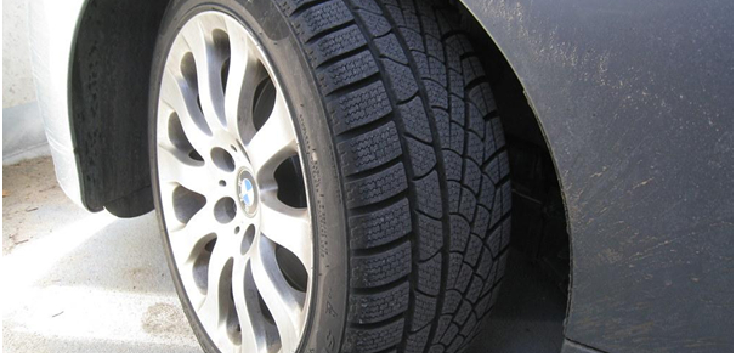Width
Current Selection:
Make
Current Selection:

Run Flat Tyres: What They Are And Do You Need Them
If you ever heard the term “run flat tyres” you probably don’t know what these tyres are or how they work in detail. Also known as self-supporting tyres, run flats are a model that is designed to keep working for a short while even after the tyre suffers a puncture.
In other words, having a run flat tyre means that you are always safe on the road, even if you undergo a puncture. In most of the cases like these, you should be able to safely drive home or to the nearest UAE tyre repair shop for a change.
Run flat tyres also reduce the dangers of potentially dangerous tyre blowouts due to their unique material and construction.

A Brief History Of Run Flat Tyres
If you have been browsing and looking for the best UAE run flat tyres, it is worth knowing more than just their basic characteristics.
The origins of this tyre system started in 1935, when Michelin introduced a tyre that was based on technology developed for local computer trains and trolleys. This tyre had a safety rim inside it, allowing it to run on a special foam lining if punctured. The tyre was sold for military use and specialized vehicles such as bank armored cars.
In 1958, Chrysler teamed up with Goodyear to offer their first Captive Air run-flat tyres using an interlining carrying the weight. In 1972, Dunlop followed and launched the Total Mobility Tyre along with a “fail-safe” wheel – a system which became optional equipment on the Rover P6 3500 in 1973.
First appearing in the mid-1980s, the concept of run flat tyres (RFT) is now a lot more popular than ever before. Some auto manufacturers have made them standard in new vehicles, which is how their popularity grew – and how many brands are now using them.
Most recently, Bridgestone and Pirelli run-flat tyres are supplied on some new BMW models. The automaker promoted these as a safety feature and an alternative to carrying a spare tyre.
Pirelli’s Sotozero RFT model is a common example of run flat tyres.
How Do Run Flat Tyres Work?
Designed with reinforced sidewalls, run flat tyres are a popular model nowadays. Knowing that a car is supported by the air in its typres, punctures can seriously collapse a tyre and put the car in a non-driving condition.
However, with run flat tyres, you get tough rubber inserts which can temporarily hold up the weight of your vehicle, even after a puncture. Below, we are listing some of the most commonly asked questions about run flat tyres and their answers.
How long can you drive with a punctured run flat tyre?
If your run flat tyre suffers a puncture, you obviously cannot drive it forever. In most of the cases, you can drive it at 30 miles per hour for another 50 miles. This is still plenty of time to get to your nearest UAE tyre change shop. The exact range still varies with different run flat tyre models, as well as variables like driving speed, the load of the vehicle and the driving conditions at the moment.
Are there vehicles that come fitted with a run flat tyre as their ‘Original Equipment’ (OE)?
Many popular vehicle manufacturers turn to run flat tyres as an option in their newest models. So, if you want to buy a new BMW 5 Series, Audi A6 or a Mini, for example, you should know that it will come with four run flat tyres and in most of the cases, without a spare tyre or one that can be replaced if a puncture occurs.
Can run flat tyres be repaired?
This is another very common question people have when considering run flat tyres.
Generally speaking, most tyre repair experts and tyre manufacturers are against repairing run flat tyres. If the deflated tyre has been punctured and been driven on, its strength, agility and grip may have been compromised. The best way to know whether you can repair a run flat tyre is to visit your local Dubai or Abu Dhabi tyre repair expert.
Can you mix conventional tyres with run flat tyres?
The answer is no. You should avoid mixing different tyre types on a vehicle, mostly because of the different suspension and other unique requirements that run flat tyres demand. Ultimately, the handling characteristics of the vehicle may differ.
Which vehicles have run flat tyres?
BMW promotes run flat technology to enhance driver comfort and safety. The suspension and braking are set up accordingly, so changing to conventional tyres can affect the handling characteristics of the car.
Can you use run flat tyres on towing caravans and/or trailers?
Run flat tyres can be used only on vehicles fitted with TPMS (tyre pressure monitoring system). Caravans and trailers are not currently fitted with this system, which is why they should not be equipped with run flats.

Source: Bridgestonetire.com
Should You Change From Run Flat To Conventional Tyres (And Vice Versa)
The decision of driving a car with run flat tyres or conventional ones is different and quite subjective. What you should know is that changing from run flat tyres to normal ones (or vice versa) could affect the handling of your car, which is why you should consult with the manufacturer before changing your tyres.
However, there are still many people who choose conventional tyres over run flat ones because:
- Conventional tyres are cheaper than run flat tyres and more available on the market
- Many people believe that convetnional tyres are smoother, and offering a less bumpy ride
- Run flat tyres are not always repaired which brings an additional cost to the equation
On the other hand, in some cases run flat tyres are better than conventional ones, especially if you appreciate the following:
- Freedom to choose where you want to change your tire after a puncture
- Safer handling in an air-loss situation
- Comfort knowing that you can still drive even after a puncture
Fitting A Run Flat Tyre To An Older Vehicle (Also Known As “RetroFitting”)
If you are seriously considering changing your conventional tyres in UAE to run flat tyres on a vehicle that was previously fitted with ‘normal’ tyres, then there are several points to consider, including:
- Your Tyre Pressure Monitoring System – Run flats must be installed on a car with a TPMS/tyre pressure monitoring system. This system alerts the driver to a puncture, making them aware that they have a limited time to replace that tyre.
- Your Vehicle Suspension – There may be some changes to the vehicle’s suspension that you need to make if you want to retrofit your car with run flat tyres. Because of their stiffer construction, run flats contribute to a vehicle’s suspension when they are fitted as original equipment.
According to the BTMA (2005), retrofitting conventional tyres in place of run flat tyres would “remove the run-flat capability, potentially leaving the driver immobile in a case of deflation and could compromise vehicle handling. It is therefore recommended to consult with the vehicle manufacturer before replacing SSTs with conventional tyres.”
All in all, retrofitting is a good way if you want the very best out of run flat tyres. The compounds are normally injected through the tyre valve, and the rotating force then distributes the compound to the inner surface of the tyre, acting as a self-sealing lining in the tyre structure.
Final Words
In the end, run flat tyres are a solid option only if you fully understand the system and its advantages/disadvantages. If you have doubts or don’t know whether your vehicle can support this model, the best way is to get in touch with a licensed tyre expert.




The information below is required for social login